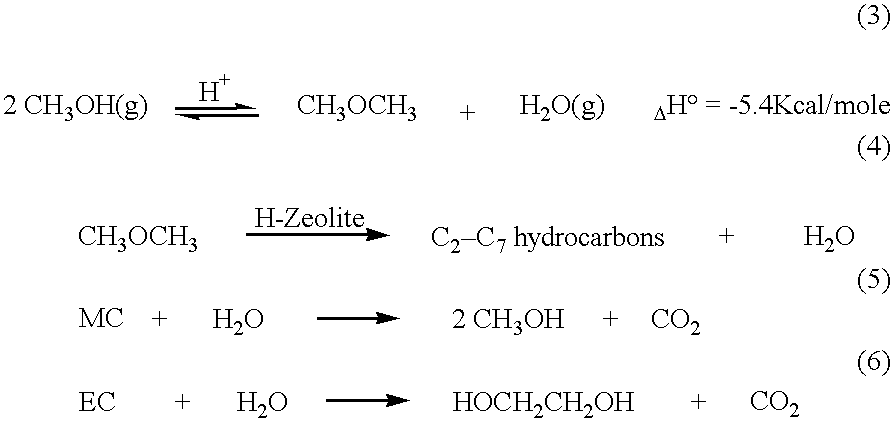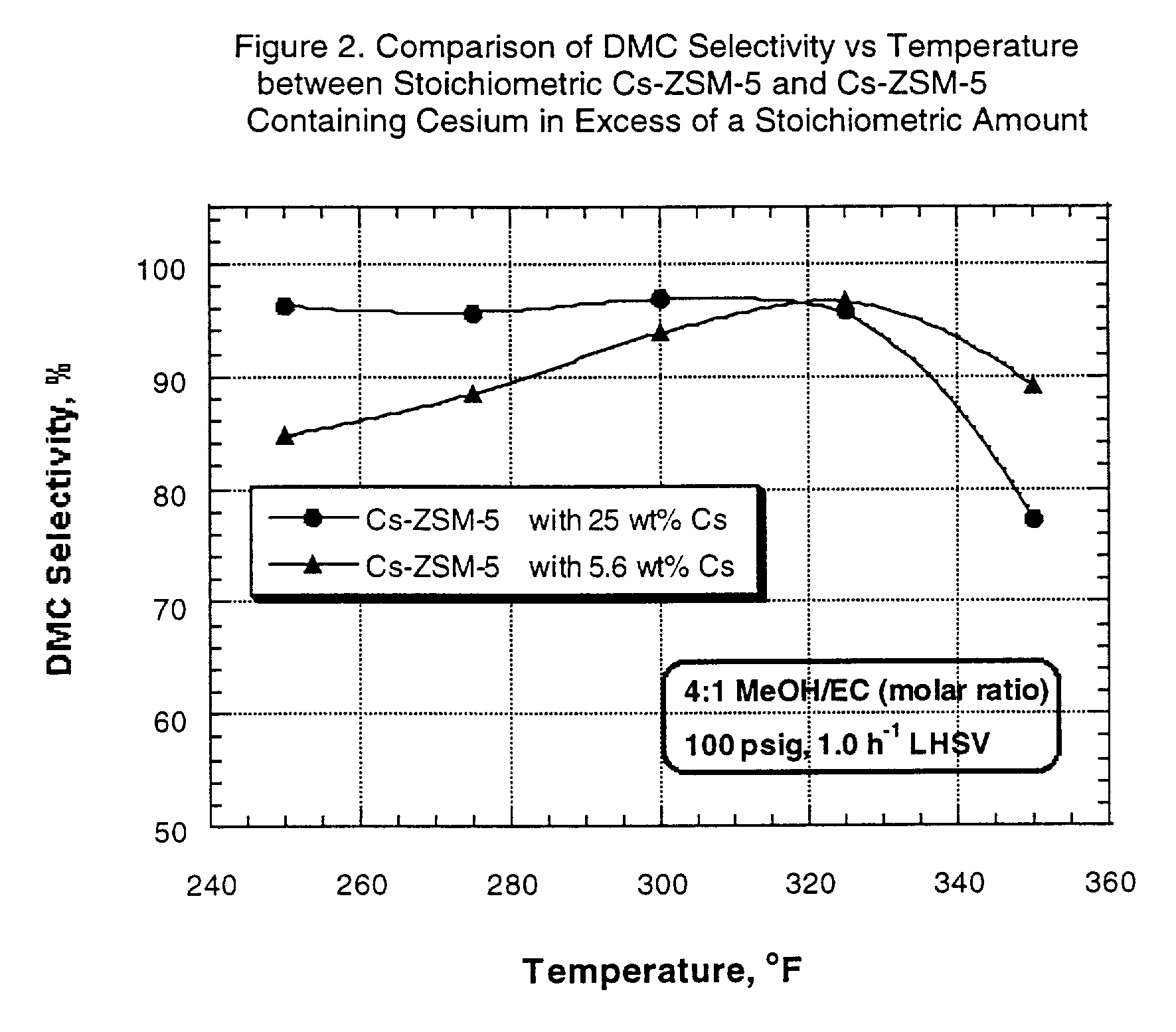Process for co-production of dialkyl carbonate and alkanediol
- Summary
- Abstract
- Description
- Claims
- Application Information
AI Technical Summary
Benefits of technology
Problems solved by technology
Method used
Image
Examples
example 1
This example describes a method for preparing three catalysts employed in the comparative examples. Cs-ZSM-5 with 25 wt % Cs is an example of a catalyst used in the method of the invention having alkali and / or alkaline earth metal in excess of a stoichiometric amount. Cs-ZSM-5 with 5.6 wt % Cs is an example of a stoichiometric catalyst. K-zeolite A (3A molecular sieves) is a commercially available catalyst, which also contains a stoichiometric amount of metal. The physical properties of the three zeolite samples are shown in Table 1.
The Cs-ZSM-5 with 25 wt % Cs was prepared using 55:1 SiO.sub.2 / Al.sub.2 O.sub.3 ratio ZSM-5. The ZSM-5 crystals were ammonium exchanged twice using 5 cc / g of 1 M solution of NH.sub.4 NO.sub.3 followed by drying at 250.degree. F. (120.degree. C.) overnight. The dried ZSM-5 was calcined under flowing N.sub.2 at 900.degree. F. (482.degree. C.) for 3 hours. Air (2 v / v / min) was then gradually introduced and the temperature was raised to 1000.degree. F. (538...
example 2
This example describes the NMR characterization of the stoichiometric Cs-ZSM-5 (5.6 wt % Cs) and excess stoichiometric Cs-ZSM-5 (25 wt % Cs) catalysts.
500.13 MHZ .sup.1 H MAS NMR spectra were obtained on a 500 MHZ Bruker AMX spectrometer using 10.0 kHz sample spinning, 7.0 .mu.s 90 degree excitation pulses, and a 60 s recycle time. H.sub.2 O was used as the external chemical shift reference. The samples were dried overnight at 400.degree. C. (752.degree. F.) under vacuum prior to packing the samples in a glove box and obtaining the .sup.1 H NMR spectra. 65.6 MHZ .sup.133 Cs MAS NMR spectra were obtained on a 500 MHZ Bruker AMX spectrometer using 10.0 kHz sample spinning, short 0.8 .mu.s excitation pulses, and a 0.5 s recycle time. 0.5M CsCl was the external chemical shift and quantitation standard. All samples were equilibrated at 100% humidity prior to obtaining the .sup.133 Cs NMR spectrum.
The .sup.133 Cs NMR spectrum of Cs-ZSM-5 with 25 wt % Cs shows two resonance absorptions at ...
example 3
Transesterification experiments were performed using each of the catalysts described in Example 1. The catalysts were utilized in the transesterification of ethylene carbonate (EC) with methanol (MeOH) to form dimethyl carbonate (DMC) and ethylene glycol (EG).
The experiments were run in a fixed bed microunit equipped with a three-zone furnace and a down-flow trickle-bed tubular reactor (1 / 2" ID). The catalysts were sized to 60-80 mesh, and the reactor was loaded with a mixture of 10 cc of the sized catalyst and 3 cc of 80-120 mesh sand.
After pressure testing of the unit, the catalyst was dried at 400.degree. F. (204.degree. C.) for two hours under 1 atmosphere, 170 cc / min nitrogen flow. At the end of this period, the reactor was cooled down to 150.degree. F. (66.degree. C.) and nitrogen flow was stopped. The reactor pressure, controlled by a pressure regulator, was then set to 100 psi, and the EC / methanol mixture feed was pumped and added to the top of the reactor at 1.0 h.sup.-1 LH...
PUM
| Property | Measurement | Unit |
|---|---|---|
| Time | aaaaa | aaaaa |
| Pressure | aaaaa | aaaaa |
| Angle | aaaaa | aaaaa |
Abstract
Description
Claims
Application Information
 Login to View More
Login to View More - R&D
- Intellectual Property
- Life Sciences
- Materials
- Tech Scout
- Unparalleled Data Quality
- Higher Quality Content
- 60% Fewer Hallucinations
Browse by: Latest US Patents, China's latest patents, Technical Efficacy Thesaurus, Application Domain, Technology Topic, Popular Technical Reports.
© 2025 PatSnap. All rights reserved.Legal|Privacy policy|Modern Slavery Act Transparency Statement|Sitemap|About US| Contact US: help@patsnap.com



